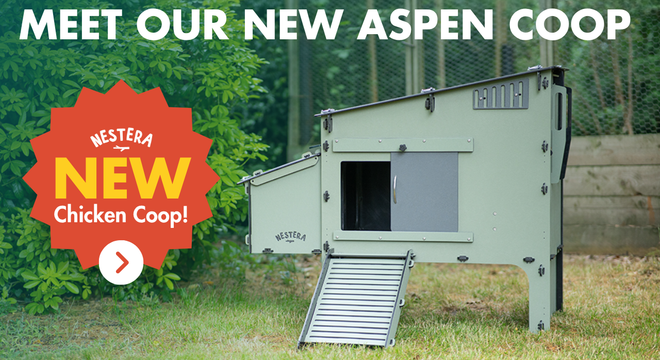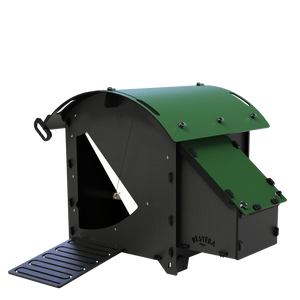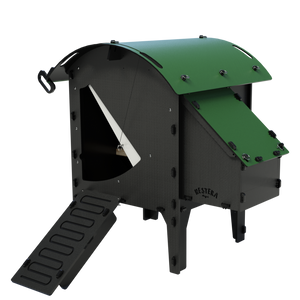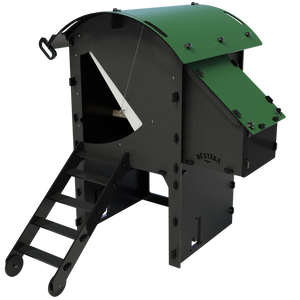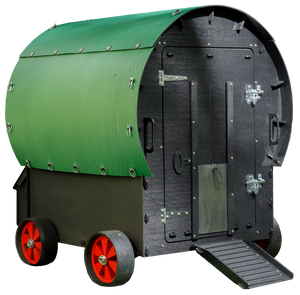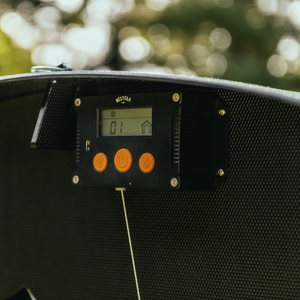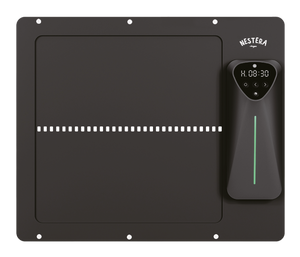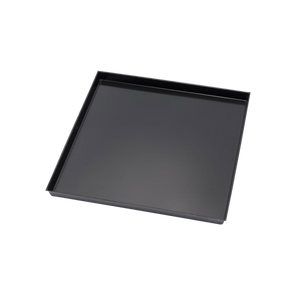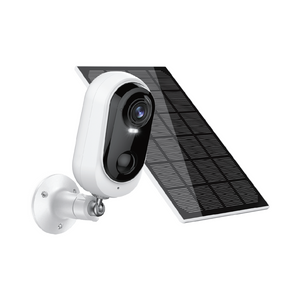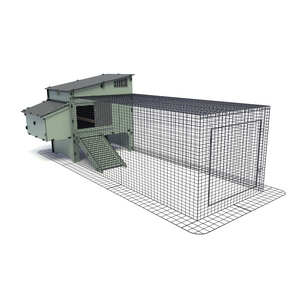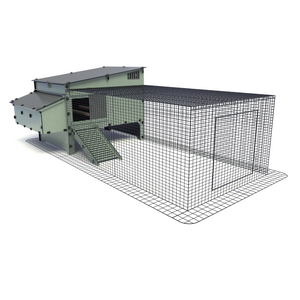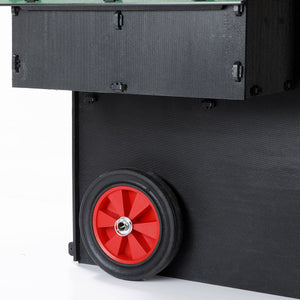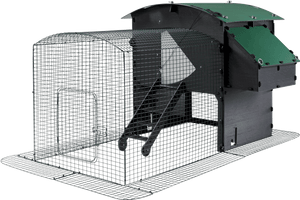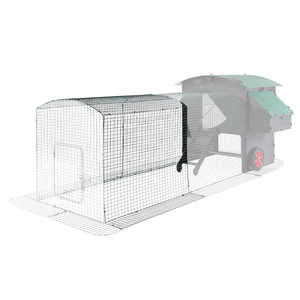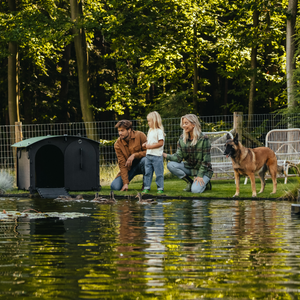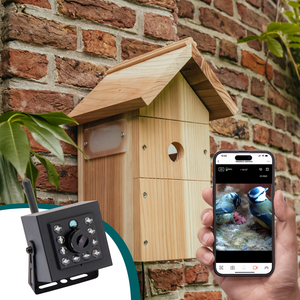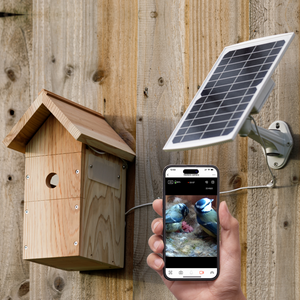Page title: FAQ
Got a question? You'll probably find the answer here!
Chicken Coops
Are Nestera chicken coops fox-proof?
We really think so! We've not received a single report of a fox getting into one of our coops. Our ‘chew-resistant’ coops are made from recycled plastic which is really tough, and the ventilation holes are far too small for a fox. The rear door is lockable and the front door is reinforced with rotating metal slide, which makes it difficult to open by lifting, unlike classic vertical sliding doors.
Are plastic chicken coops red mite-proof?
Unfortunately, nothing is 100% red mite-proof. However, Nestera chicken coops are cleverly designed to be extremely red mite-resistant! Red mites are tiny, and live in cracks and joints in poultry housing. Unlike wooden chicken coops, ours are made from solid recycled plastic and created to ensure there are very few suitable places for red mite to hide. We recommend sprinkling Diatom powder around the coop when refreshing the bedding, so any mites present are quickly dealt with before they can multiply.
Do plastic chicken coops get cold in winter and/or hot in the summer?
The plastic we use is partially recycled (at least 70%) which we have found to be an excellent material for chicken coops. In the winter months, the required ventilation means the temperature inside the coop will be similar to the ambient air temperature outside. However, chickens are quite tolerant of the cold as their feathers provide good insulation. During the warmer summer months, our solid, UV-resistant roofs reflects the sun's heat really well, keeping your chickens cool and comfortable.
How many chickens can live in a Nestera chicken coop?
For our standard range, we have three sizes available: Small, Medium and Large. The Small is designed for up to two large fowls or four bantams, the Medium for up to five large fowls or nine bantams and the Large suits up to eight large fowls or 15 bantams.
The Wagon is suitable for up to eight large birds or 15 bantams.
Can I install an automatic door opener on a Nestera coop?
Absolutely! We offer an Automatic Door Opener as an optional extra for all our coops. Discreet pre-drilled holes are included for easy installation.
How long does it take to assemble a Nestera chicken coop?
Most people manage to successfully assemble their Nestera chicken coop in under an hour. You certainly don’t need to be a DIY expert! We provide clear and easy-to-follow instructions with every plastic chicken coop which can also be downloaded above.
What type of chicken coop is best for me?
When asking what type of chicken coop is best for me, you need to consider a few things:
The first is how many chickens do I have/am I getting? Nestera chicken coops can comfortably house between 3 and 8 large chickens (or 15 Bantams).
The second thing to consider is whether you will have chicks. If this is the case, we recommend the House Coop because these are low to the ground, providing easy access for broody hens and chicks.
If you want to raise your flock off the ground, we recommend a Lodge or a Penthouse Coop; these both offer a sheltered area under the coop for your hens to feed, play and take cover from any adverse weather.
Coop WiFi Camera
Automatic Door Opener
How is the Nestera Automatic Door Opener powered?
The Automatic Door Opener is powered by 4 x AA batteries (included).
Why does the LCD display not remain illuminated?
Don’t worry, this is normal. To preserve battery life, the LCD display is designed to enter ‘sleep mode’ after a period of inactivity. You can ‘wake’ it again by pressing the Menu button.
My Automatic Door Opener is set up correctly but it’s not working...
Please ensure all 4 x AA batteries are new and inserted correctly, and that the battery cable wire is not being pinched between the lid and the box. It’s also worth checking that any connector cables haven’t been accidentally loosened while fitting the unit.
If these steps don’t offer a solution, drop us a line at support@nestera.eco and we’ll have you up and running in no time.
Why isn’t the light sensor working on my Automatic Door Opener?
The light sensor is designed to activate the coop door over a gradual light change. This ensures the door isn’t opened automatically in a lightning storm or in car headlights, for example. The sensor takes an average light reading every three minutes to account for this.
Please note, if your automatic door opener is positioned near a floodlight or streetlight, this may affect the light sensor. It is best to position your coop away from ambient lighting.
How long is the cord on the Automatic Door Opener?
The cord provided with the unit is 1.5m long. Please bear in mind that this includes a small length that needs to remain wound around the spindle inside the unit.
The E4 error message is displaying on the Automatic Door Opener screen - what should I do?
Restart the door calibration process with open and closed position of the door.
Press the main button to activate the screen and press it a second time to enter the main menu.
Step 1: Calibrate the door in its open position and confirm the position with the main button
Step 2: Repeat in the door closed position.
Step 3: Select mode for door opening: Manual, Timer or Sensor.
Step 4: Repeat mode selection for door closing: Manual, Timer or Sensor.
If Sensor mode is selected, choose the LUX (light) level you want to trigger the for opening and closing process.
Keeping Chickens
Can I keep chickens in a residential area?
As long as you have a garden or outdoor space, you can keep chickens and enjoy freshly laid eggs every morning. Whether you live in the city or countryside, an increasing number of people are now keeping chickens in their garden, mainly due to how easy it is. However, we recommend checking with your local authority first, as a small number don’t allow chickens to be kept in gardens. If you rent your property, we advise you to check your tenancy agreement as it will likely include rules about keeping animals.
How much space do I need to keep chickens?
Luckily, chickens don't require a lot of space. The absolute minimum area for a run is 1 square metre per bird but the more space you can provide for your birds, the better; so we recommend at least 2 square metres per bird. Many people grant their chickens free reign of their entire garden, but it's worth remembering some chickens enjoy making a mess, so a run may be preferable.
Can I keep chickens on my allotment?
The 1950 Allotment Act states you can keep chickens on an allotment as long as they are for the allotment holders’ use only and not used for business or profit. However, we suggest you check your specific allotment's rules as some allotment landlords do not allow poultry. If there is a complaint about your birds being a nuisance or a health hazard, or if their welfare is affected in any way, the authorities have the power to remove them.
Are chickens noisy?
Generally, no. Hens do make a range of noises, but these are mostly gentle and quiet... until they've laid an egg, when they like to have a quick shout about their achievement - and who can blame them? The noisy ones are the males, known as roosters or cockerels. They are territorial birds and love nothing better than regularly telling everyone that the hens are his!
Cockerels traditionally also crow loudly at sunrise. Because chickens are early risers, when the sun comes up every morning, he will proudly announce his presence to the world. However, not everyone appreciates this early morning wake-up call, so this is something to consider if you have neighbours living nearby.
Do chickens get on with children?
If handled from young, chickens will become very tame and make fantastic family pets. Keeping chickens in your garden is great fun for children of all ages and provides hours of entertainment, as well as the opportunity to learn about sustainability, caring for animals and where eggs comes from.
Is keeping chickens time-consuming?
Keeping chickens is really easy and doesn't require a of your time. Chickens are quite happy occupying themselves by exploring your garden or their run. The only things chickens require of you is to let them out of their coop in the morning (although this can be done with our Automatic Door Opener), ensure they have sufficient food and water, remove their eggs and put them back into their coop at night. Their coop will need cleaning out once a week - but our cleverly designed Nestera coops ensure this is always a very quick and easy job!
What is the best chicken coop for beginners?
Most novice chicken keepers usually start with a small, manageable number of hens, and when we’re asked what is the best chicken coop for beginners, we always recommend the Nestera House Coop. It’s the perfect entry-level chicken coop - not only does its clever design prevent red mite infestations but it sits low to the ground, providing easy access for broody hens and young chicks. The House Coop is available in three sizes to comfortably house up to eight large hens or 15 Bantams.
What is the healthiest chicken coop?
Unlike traditional wooden coops, the smooth interior surfaces of Nestera plastic chicken coops leave nowhere for red mites to hide, meaning your hens won’t be subjected to painful (and sometimes deadly) red mite infestations. Not only that, but the 100% recycled plastic we use makes the coop cleaning process a piece of cake - a quick hose-down is all it takes, and the plastic dries in moments! Plus, every Nestera chicken coop comes with at least two fully-adjustable vents to keep your flock at the ideal temperature all year round.
A Nestera coop means happier, healthier hens!
What are the downsides of a chicken coop?
As experienced chicken keepers, we know that owning chickens is very fun and extremely rewarding. But with fun comes responsibility, which is why we’ve created our coops to minimise the downsides of chicken keeping.
Traditionally, chicken coops have been made of wood which are difficult to clean, take hours to dry and easily harbour red mite. Nestera coops are made from 100% recycled plastic and intelligently designed to make chicken keeping a doddle! Nestera coops prevent red mite, make the cleaning process a doddle, and include fully-adjustable air vents to provide the perfect amount of airflow whatever the weather.
What is the best material for inside a chicken coop?
Traditional wooden chicken coops come with a huge number of disadvantages: they are a pain to keep clean, take ages to dry and are an easy target for red mite infestations.
When designing our chicken coops, we took all these pain points into consideration and discovered plastic is a far better option - and not just any plastic, but 100% recycled (and recyclable) plastic.
Nestera’s smooth interiors not only leave nowhere for swarms of red mites to hide and harm your hens, but make the coop cleaning process far quicker and easier than with a wooden coop - just hose it down and it’ll be dry in moments!
How many nesting boxes do I need for 6 chickens?
For up to 6-8 chickens, we recommend at least two nesting boxes. Each of our medium and large coops from the Ground, Lodge and Raised ranges (plus the Wagon) all offer two secure nesting boxes for your hens to lay their eggs in comfort. The small Ground, Lodge and Raised Coops feature a single nesting box, which is suitable for 3-5 hens.
How many chickens should you have in one coop?
We are often asked how many chickens you should have in one coop, and this depends on several factors, including the breed of chicken, and their size. It’s important to remember that chickens need plenty of space to move around, roost and lay eggs. Overcrowding a coop can lead to health issues, stress and aggressive behaviour, so we always recommend to err on the side of caution and provide your chickens with a little more space than they strictly need.
Every Nestera coop is available in three sizes: Small, Medium and Large. The Small can house up to 3 large hens or 5 Bantams; the Medium up to 5 large hens or 9 Bantams; and the Large (and the Wagon) up to 8 large hens or 15 Bantams.
What is the best bedding for a chicken coop?
Two of the most commonly used materials for coop bedding are wood shavings and sand. Aesthetically, sand looks cleaner and has been proven by Auburn University researchers to lower coliform counts, including E.coli, compared to wood shavings.
You can even sprinkle fresh nest herbs like these onto your coop bedding. The natural oils in the marigolds, rose buds, lavender, lemon balm, cornflowers and chamomile help relax and calm your hens. They also smell great and discourage pests.
Some people recommend straw as an appropriate bedding material; however, it’s worth noting that the hollow straw fibres provide an ideal place for red mites to hide.
We offer removable droppings trays for all our coops, which makes the cleaning process quick and easy, and ensures a far more hygienic coop for both you and your flock.
What is the best number of chickens to start with?
Chickens are highly flock-orientated, so for a starter flock size we recommend no fewer than three chickens. You can expect around 12 eggs per collection (every couple of days) from three laying hens. If you have no previous experience looking after chickens, it’s best to start with a smaller flock, as you can always grow it once you’ve established a routine.
For a slightly larger family with a higher egg consumption, a flock of five or six hens is a good choice.
Nestera chicken coops can comfortably house between 3-8 large hens, or 5-15 Bantams.
How do I keep my coop warm in the winter?
Luckily, the recycled plastic we use for our chicken coops is an excellent thermal insulator, and when combined with the fully-adjustable ventilation featured on every Nestera coop, it provides ideal temperatures for your hens all year round. However, if required in the depths of winter, you can cover your coop with a blanket to help it retain heat - just make sure the adjustable vents are uncovered to provide adequate airflow.
We always recommend providing a warm, dry coop floor with biodegradable bedding for your hens. Our removable droppings trays are perfect for this!
How cold is too cold for chickens?
Most chicken breeds are hardy enough to handle the cold weather. There is no official yardstick of what temperature is too cold for chickens (in Canada, chickens are often kept successfully at -20°C!) - and in fact, it’s heat that causes chickens more problems.
To ensure chickens can cope well with cold weather, it’s important to establish a routine that keeps them fit and healthy throughout the year. Chickens need feathers to keep themselves warm and ensuring your flock is healthy means they will have sufficient plumage to preserve their body heat when it’s cold.
How do you know if chickens are too cold?
A chicken’s average body temperature is around 41.1°C, but this body temperature lowers when it loses more heat than it can produce. Chickens often huddle together at night time on their perch; they may hold a foot up to their breast; or they’ll puff their feathers out to stay warm in their coop.
What is the most cold-hardy chicken?
Whether you keep chickens recreationally or commercially, if you live in a cold climate you’ll know not all chickens can cope with the coldest winter conditions. Five of the hardiest breeds for cold weather are Sussex, Silkie, Rhode Island Reds, Plymouth Rocks, and Welsummer.
Do chicken coops need four walls?
One of the main reasons for a chicken coop is to offer your flock protection from the weather and predators. Providing your hens a chicken coop with four walls and a roof will keep them safe and healthy. Other basic elements every coop should have include proper ventilation, nesting boxes and secure perches.
Every Nestera chicken coop offers all these features as standard and each has been intelligently designed to offer not just safety for your flock, but luxury too!
Bird Box Cameras
What is the range of WiFi signal for the bird box camera?
The range is approximately 15-20m depending on the environment and the range of your router.
I have connected my camera and have sound but no image...
Do some quick checks:
Have you left the lens cap or protective lens sticker on on the camera? (We've all done it!)
Are all the cable connections firmly plugged in?
If these don't resolve the issue, get in touch with support@nestera.eco and we'll have you up and running in no time.
How do I pair my bird box camera with my phone?
Just follow the simple step-by-step instructions on our free Nestera Bird Cam app for iOS and Android smart devices. All our bird box cameras include a set of printed instructions, too - which can also be downloaded from the product page.
Download our free Nestera Bird Cam app:
iOS users please click here
Android users please click here
Are Nestera bird box camera systems simple to set up and use?
Yes they are. No technical knowledge is required, and to make things as easy as possible, we included clear, easy-to-follow instructions with each order. Plus, we’re always on hand should you need any help, support or advice. Get in touch with support@nestera.eco.
Why is my camera showing a black and white image during the day?
This probably means not enough natural light is getting into the bird box. When positioning your bird box, aim to keep the translucent windows on each side reasonably clear of foliage or other obstructions to ensure enough natural light can enter the nesting chamber.
To maximise the chances of birds nesting, we only use natural daylight to illuminate the inside of our bird boxes. A drop in light will trigger the LUX sensor and activate the infrared LEDs which are designed to provide black and white images when it’s dark.
How do I share access to my camera’s feed with my friends and family?
Simply tap ‘Share Device’ in the Nestera Bird Cam app settings and select any contact on your phone to send them an invitation.
Once they’ve downloaded the free Nestera Bird Cam app and created an account, you can then grant them access to your camera.
When is the best time of year to put up a bird box?
You should aim to have your bird box in place by the end of February or the beginning of March. Garden birds start breeding around mid-February. However, we have known bird boxes put up as late as April to have success.
How do I clean my Nestera bird box?
Simply use boiling water to clean out your nest box. We recommend old nests be removed from August onwards (or once you are certain the birds have stopped using the nest box).
Most birds' nests harbour fleas and other parasites which can remain in situ to infest young birds that hatch the following year. Boiling water kills any remaining parasites. Always let the box dry out thoroughly before replacing the front or top panels.
It's important to never use insecticides or flea powders in your bird box.
Is it normal for some of the eggs in the nest to not hatch or for some chicks to die?
Sadly, yes. It's quite normal for a few eggs to fail to hatch, or for some young to die. Blue and great tits sometimes lay up to 14 eggs to allow for such losses.
Cold weather and/or food shortages may lead to nest desertion, or for only the strongest of the chicks to survive. The death of one parent or interference from animals or humans may also cause nest desertion.
Please remember, if there are unhatched eggs in a nest box, these can only legally be removed between August and January.
What species of bird can I expect to nest in my bird box?
This depends on a range of factors, such as internal nest box size, entrance hole size, how high off the ground the nest box is situated, etc.
Our nest boxes are fitted with a 32mm entrance hole as standard, which will attract the widest range of garden birds, including blue tits, marsh tits, coal tits, great tits, house sparrows, and when the centre panel is removed (open fronted), you can expect nuthatches, robins, wrens and more…
Where is the best place to site my bird box?
There are a number of things to consider when mounting a Nestera bird box to maximise your chances of birds nesting in it. A more detailed checklist can be found here, but some of the key things to consider are:
Direction – face your nest box between North and East
Shelter – avoid prolonged exposure to direct sunlight
Access – ensure the birds have a clear flight path to the nest box
Height – different species prefer different distances from the ground
Fixing – tilt your nest box forward slightly so driving rain can’t penetrate the nest box.
What are Nestera bird boxes made of?
All our bird boxes are designed following RSPB and BTO recommendations and constructed from thick, durable, responsibly-sourced Western Red Cedar which proves to be extremely hardy against all weather conditions.
Will the solar panel work when it’s not sunny?
The high-performance solar panel has its own integrated 15600mA lithium-ion battery pack which is recharged by the sun and keeps the battery camera charged up.
If you notice the power on the battery camera is running low, you can simply take the solar panel indoors to recharge its battery pack with its Micro USB cable - all without disturbing the birds.
Why is my solar panel not providing any power to the battery camera?
The solar panel’s battery may have simply run down. Unplug and remove the solar panel from where it is installed and take the solar panel indoors to charge it with its Micro USB cable.
About Nestera
Nestera? Nest-who?
Nestera was established by father and son duo, Joe and Richard Freedman, who brought together the leading sustainable chicken coop company, Green Frog Designs, with Gardenature, the UK's best-trusted bird box and wildlife habitat camera company.
Nestera is focused solely on the ethos of sustainability, animal wellbeing and bringing nature closer to families.
Where are Nestera chicken coops and bird boxes made?
All our products are designed, manufactured and shipped from our UK workshop in sunny Clacton-on-Sea, Essex.
A 25-year warranty?! Am I reading that right?
Nestera plastic chicken coops are built to last! They are solidly constructed from 100% recycled plastic and do indeed come with an unbelievable 25-year warranty!
This means we will replace any parts of your coop for up to 25 years. However, we're so confident of their quality, we doubt you'll ever need to replace a part.
Other plastic chicken coop companies only offer a disappointing 2-year warranty...
What are Nestera coops made of?
Nestera chicken coops are made from 100% recycled (and recyclable) plastic, which itself is made at the world's largest energy-from-waste plant, with green biogas a by-product of the process.
Did you know... our Large chicken coop is made from the equivalent of 2,000 recycled plastic shampoo bottles? That's a lot of plastic we're taking out of circulation!
Is Nestera on social media?
Do you have an Affiliate program?
We do! Anyone can become a Nestera Affiliate and it's a great way to turn your website, blog or social channels into a source of income with very little effort! We offer a generous commission on every sale generated through our Affiliates' links.
Click here for more info and to sign up as an Nestera Affiliate. It's completely free and only takes a moment.
I'm a journalist interested in featuring a Nestera product...
Fantastic news! Contact us at marketing@nestera.eco if you need any hi-res images, logos or would like to discuss Nestera or any of our products.
Can I become a Nestera Ambassador?
We'd love you to! If you already have a Nestera product and agree to promote it to future customers, you'll receive a generous commission on every sale generated through your unique Nestera Ambassador code.
Can I see a Nestera plastic chicken coop in person before I buy?
We have a pool of Nestera Ambassadors using our products up and down the country, so there's likely to be one near you!
Let us know where you're located and we'll put you in touch with your nearest one. You can ask them for their honest opinions via email or phone, or go to visit them to see the Nestera products in person.
How do I sign up for the Nestera newsletter?
Subscribe to our newsletter by entering your email below and be the first to find out about exclusive offers, discount codes and our latest news.
Your data is completely safe with us; it will never be sold to a third party and we promise never to spam you!
Delivery
How much does delivery cost?
Delivery of small items is £5.95 and £25 for coops and Duck Houses
How long will delivery take?
Our amazing team aim to get your order dispatched within 3 working days; however, this can sometimes take a little longer.
Will I know when my order has shipped?
Yes, we'll keep you updated with every step of your coop's journey. When your order is ready to ship, you'll receive an email to let you know it's on its way.
Can I track my delivery?
Yes, you'll receive up-to-date tracking information in an email the moment it's passed to our courier for delivery. You can also log into your Nestera account at any time to check your order and/or delivery status.
Can I change or cancel my order?
To change or cancel an order, contact us by phone on 01963 371563 or email support@nestera.eco as soon as possible after ordering. You can also log into your account to check the the delivery status of your order.
What if my order, or part of it, has not arrived?
Because of their size, most orders are sent in more than one package. Very occasionally, the courier we use will deliver one order over two days.
If the second part of your order hasn't been delivered by the day after the first arrives, drop us a line at hello@nestera.eco and we'll let you know when to expect it.
How are Nestera products shipped?
Our products are all shipped flat-packed for self-assembly in fully recyclable packaging. Easy-to-follow instructions are always included and can also be downloaded here.
What if my product is damaged or missing parts?
Let us know which parts are missing or damaged and we'll send replacements out to you ASAP. Please use the part descriptions in the User Guide, so we can accurately identify each part required.
Is Nestera packaging recyclable?
Of course! We pride ourselves on our green credentials. Not only are Nestera plastic chicken coops made from 100% recycled plastic, but every last bit of the packaging it's delivered in is recyclable.
Payment
What types of payment to you accept?
We offer a huge range of payment methods: Credit or Debit Card (Visa, Mastercard, Maestro, American Express), Paypal, Google Pay, Apple Pay, Shop Pay or you can buy now and pay later with Klarna.
How do I pay for my order?
You can complete your order using our secure online Checkout, or call us on 01963 371563 to make payment securely over the phone.
Is my payment secure?
Our website has been designed and built using the highest security measures. Our online Checkout is powered by Shopify, which is certified Level 1 PCI DSS compliant. We do not store any card details on our servers and always ensure our website is kept updated.
How do I use a Nestera discount code?
To apply a discount code, simply enter it in the relevant field at the payment stage of our secure Checkout and click 'Apply'.
Returns
Can I return my order?
We want you to be 100% happy with your Nestera products.
If you are not completely satisfied with your order, we offer a no-quibble, 30-day returns policy.
Just like delivery, Nestera returns are also free.
Please note:
Unless you have discovered a fault with your coop, in the interest of animal welfare we can only accept returns if the coop has not been assembled or used.
How do I return something?
Simply email us at support@nestera.eco to arrange your return.
When will I receive my refund or replacement?
Your refund or replacement will be issued as soon as we receive your item/s. Refunds will be made within 48 hours of receipt of the item/s back to your original payment method. Please allow up to 3 working days for the refund to appear on your bank statement.
